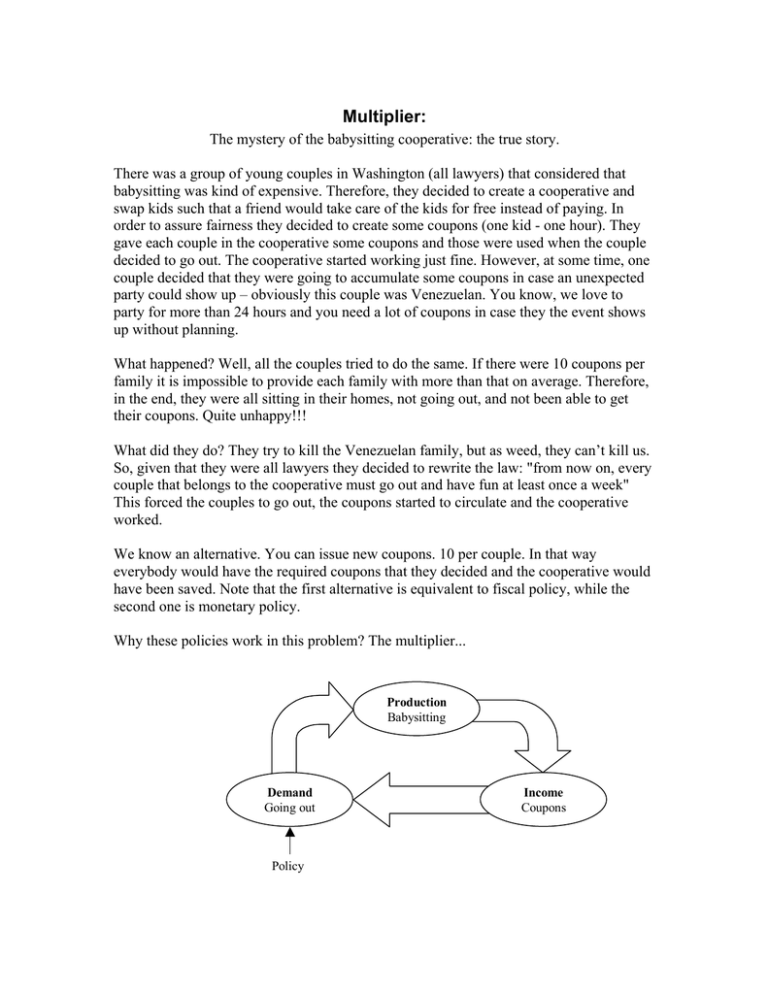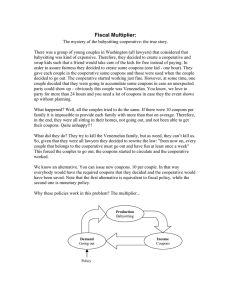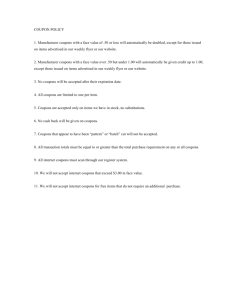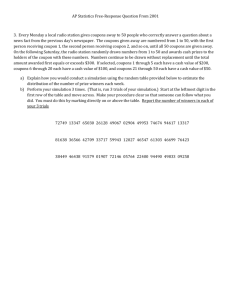Multiplier:
advertisement

Multiplier: The mystery of the babysitting cooperative: the true story. There was a group of young couples in Washington (all lawyers) that considered that babysitting was kind of expensive. Therefore, they decided to create a cooperative and swap kids such that a friend would take care of the kids for free instead of paying. In order to assure fairness they decided to create some coupons (one kid - one hour). They gave each couple in the cooperative some coupons and those were used when the couple decided to go out. The cooperative started working just fine. However, at some time, one couple decided that they were going to accumulate some coupons in case an unexpected party could show up – obviously this couple was Venezuelan. You know, we love to party for more than 24 hours and you need a lot of coupons in case they the event shows up without planning. What happened? Well, all the couples tried to do the same. If there were 10 coupons per family it is impossible to provide each family with more than that on average. Therefore, in the end, they were all sitting in their homes, not going out, and not been able to get their coupons. Quite unhappy!!! What did they do? They try to kill the Venezuelan family, but as weed, they can’t kill us. So, given that they were all lawyers they decided to rewrite the law: "from now on, every couple that belongs to the cooperative must go out and have fun at least once a week" This forced the couples to go out, the coupons started to circulate and the cooperative worked. We know an alternative. You can issue new coupons. 10 per couple. In that way everybody would have the required coupons that they decided and the cooperative would have been saved. Note that the first alternative is equivalent to fiscal policy, while the second one is monetary policy. Why these policies work in this problem? The multiplier... Production Babysitting Demand Going out Policy Income Coupons One striking feature is that this model has the implication that the more you save (more coupons you accumulate), the lower the demand is and therefore, the smaller the multiplier is. Quite a counter intuitive implication, no? At least, in comparison to what our moms have told us all our lives. Lets see how each policy works in this diagram. Fiscal Policy: We studied three fiscal policies: • Tax Cuts on individuals, usually income taxes. • Tax cuts on investment and firms usually called Investment Tax Credits, • Increases in Expenditure. FP: Investment Tax Incentives Production Babysitting Demand Going out FP: Increase in Expenditure Income Coupons FP: Tax Cut Monetary Policy: In this case we have either an increase in money supply (in the baby sitter example this implies a larger income) or a reduction in the interest rate (which will increase investment). MP: Lower Interest Rate Production Babysitting Demand Going out Income Coupons MP: Monetary Expansion MIT OpenCourseWare http://ocw.mit.edu 15.012 Applied Macro- and International Economics Spring 2011 For information about citing these materials or our Terms of Use, visit: http://ocw.mit.edu/terms.






